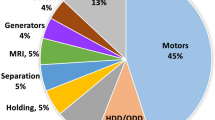Abstract
Substitution is an important response for material users when faced with disruption to the availability or price of an essential material. In economic terms, substitution refers to the ability of firms to alter their patterns of material use in response to exogenous market shocks. Substitution comes in different forms which vary from situation to situation. This paper uses expert opinion to identify the specific forms of substitution that occurred in permanent magnets, specifically neodymium–iron–boron magnets, following the significant increase in rare earth prices in 2010–2011. The paper provides a framework for understanding the multifaceted nature of substitution and assesses the relative importance of five different types of substitution. Technology-for-element, grade-for-grade, and system-for-system substitution appear to have been more important than element-for-element and magnet-for-magnet substitution. Cost pass-through and absorption were also important responses.


Similar content being viewed by others
Notes
In economic analysis, substitutability is generally measured through elasticities, specifically the price elasticities of demand and supply and the elasticity of substitution between two inputs. Estimating elasticities empirically requires a substantial amount of historical data. Please see Refs. 4 and 5 for more information on elasticity estimation using econometric techniques.
Element-for-element substitution also does not refer to substituting completely different elements to produce similar, but different, magnet types.
While HRE diffusion allows for a lower HRE content by weight, it does necessitate an increase in the neodymium/praseodymium mix such that the total rare earth content of the magnet remains roughly the same. In economics, this is a different concept from a true improvement in technology, which implies the ability to use less total inputs for the same output.
There is also a newer technology referred to as the dual alloy method in which one of the constituent alloys, containing dysprosium or terbium, is a lower melting alloy and permits conventional powder metallurgy production without extra manufacturing steps and the associated costs. This technology has patents applied for in 2014–2015 by Shin-Etsu.23
In microeconomics, reversibility refers to the ability to move up and down the demand curve at will in response to price changes. If the new quantity demanded persists after prices revert back to their original state (that is, if demand is not reversible), then the original shift describes a shift in the demand curve, rather than a shift along the curve.
In the dual alloy method, no extra manufacturing steps or costs are required, so manufacturers would likely not switch back to traditional techniques if using this method.
References
US Department of Energy, Critical Materials Strategy (US Department of Energy, 2011), http://energy.gov/sites/prod/files/DOE_CMS2011_FINAL_Full.pdf. Accessed 13 Jan 2016.
T.E. Graedel, R. Barr, C. Chandler, T. Chase, J. Choi, L. Christoffersen, E. Friedlander, C. Henly, C. Jun, N. Nassar, D. Schechner, S. Warren, M. Yang, and C. Zhu, Environ. Sci. Technol. 46, 1063 (2011).
T.E. Graedel, E.M. Harper, N.T. Nassar, and B.K. Reck, Proc. Natl. Acad. Sci. U.S.A. 112, 6295 (2015).
M.E. Slade, Resour. Policy 7, 103 (1981).
J.T. Cuddington and L. Dagher, Energy J. 36, 185 (2015).
D.I. Bleiwas and J. Gambogi, United States Geological Survey (2013), http://pubs.usgs.gov/of/2013/1072/OFR2013-1072.pdf. Accessed 13 Jan 2016.
US Geological Survey, (US Geological Survey, 2011), http://minerals.usgs.gov/minerals/pubs/commodity/rare_earths/mcs-2011-raree.pdf. Accessed 13 Jan 2016.
US Geological Survey, Mineral Commodity Summaries 2015: Rare Earths (US Geological Survey, 2015), http://minerals.usgs.gov/minerals/pubs/commodity/rare_earths/mcs-2015-raree.pdf. Accessed 13 Jan 2016.
Roskill Information Services Ltd., Rare Earths: Market Outlook to 2020 (Roskill Information Services Ltd., London), pp. 50–54.
S. Constantinides, 51st Annual Conference of Metallurgists (Niagara Falls, 2012).
Arnold Magnetics, Neodymium-Iron-Boron Magnets, http://www.arnoldmagnetics.com/en-us/Products/Neodymium-Magnets. Accessed 13 Jan 2016.
Arnold Magnetics, REMCOMA Samarium Cobalt Magnets, http://www.arnoldmagnetics.com/en-us/Products/RECOMA-SmCo-Magnets-en. Accessed 7 March 2016.
K&J Magnetics, Inc., Magnet Grades, https://www.kjmagnetics.com/blog.asp?p=magnet-grade. Accessed 7 March 2016.
J.E. Tilton, Material Substitution: Lessons from Tin-Using Industries, ed. J.E. Tilton (Baltimore: Johns Hopkins University Press, 1983), pp. 1–11.
J.E. Tilton, Conserv. Recycl. 7, 21 (1984).
F.R. Demler, Material Substitution: Lessons from Tin-Using Industries, ed. J.E. Tilton (Baltimore: Johns Hopkins University Press, 1983), pp. 15–35.
P.D. Canavan, Material Substitution: Lessons from Tin-Using Industries, ed. J.E. Tilton (Baltimore: Johns Hopkins University Press, 1983), pp. 36–75.
J.E. Tilton, Technol. Forecast. Soc. 39, 127 (1991).
U.S. Congressional Budget Office, Cobalt: Policy Options for a Strategic Mineral (U.S. Congressional Budget Office, 1982), pp. 10–11, https://www.cbo.gov/sites/default/files/cbofiles/ftpdocs/51xx/doc5126/doc29-entire.pdf. Accessed 20 Jan 2016.
S. Duclos, J. Otto, and D. Konitzer, Mech. Eng. 132, 36 (2010).
Roskill Information Services Ltd., Rare Earths: Market Outlook to 2020 (London, Roskill Information Services Ltd.), pp. 178–213.
S. Rashidi, Use, Reduction and Probable Remedies of Heavy Rare Earth Metals in Neodymium Iron Boron Alloys (Tridus Magnetics and Assemblies, 2011), http://www.tridus.com/news/2011/7/use-reduction-and-probable-remedies-of-heavy-rare-earth-metals-in-neodymium-iron-boron-alloys.aspx. Accessed 1 March 2016.
Critical Materials Institute, U.S. Rare Earth Magnet Patents Table (Critical Materials Institutue, 2016), pp. 23–24, https://cmi.ameslab.gov/resources/magnet-table. Accessed 2 March 2016.
Acknowledgements
We thank the numerous experts who consented to be interviewed. Without their comments, this research would not be possible. In addition, an anonymous reviewer provided valuable feedback on much of the technical discussion. This work is supported by the Critical Materials Institute, an Energy Innovation Hub funded by the U.S. Department of Energy, Office of Energy Efficiency and Renewable Energy, Advanced Manufacturing Office. The authors declare that they have no conflict of interest.
Author information
Authors and Affiliations
Corresponding author
Rights and permissions
About this article
Cite this article
Smith, B.J., Eggert, R.G. Multifaceted Material Substitution: The Case of NdFeB Magnets, 2010–2015. JOM 68, 1964–1971 (2016). https://doi.org/10.1007/s11837-016-1913-2
Received:
Accepted:
Published:
Issue Date:
DOI: https://doi.org/10.1007/s11837-016-1913-2




